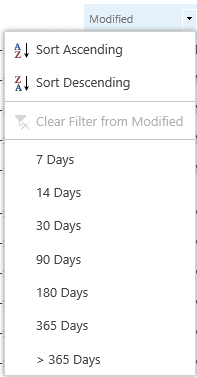
|
 |

|
 |

|
 |

|

|
* The Site Collection view described in this topic applies to the Nintex Workflow Enterprise Edition. The Site view applies to all editions.
The Workflow Inventory page opens and displays all workflows that have been created within the site.
View all workflows in a range of days

To change the view, you can sort the list in ascending and descending order.
View statistics
View all workflows for the site collection
Determine the status of your workflows
Take an inventory of your workflows
This help topic provides instructions for administrators on accessing and viewing workflow inventories from the Workflow Inventory page. This page provides a holistic view of the location, depth and breadth of existing workflows across a site collection or site.
Accessing workflow inventories
You can access the Workflow Inventory page in the following ways:
- On the Site Settings page, under Nintex Workflow, click Workflow inventory.
- Navigate to the site. On the top right, click Settings
 and select Nintex Workflows 2013, Manage Workflow Inventory from the drop-down menu.
and select Nintex Workflows 2013, Manage Workflow Inventory from the drop-down menu.
The table view shows the name of the workflow including the description, who last modified the workflow, and what list the workflow is assigned to.
Viewing workflow inventories
With the appropriate administrator rights, you can view and filter workflow inventories based on site collection, site, list, or date. Inventories can be exported as CSV files.
Note: The ability to view a workflow, list, site, site collection is based on your SharePoint administrator access permissions. For more information about permissions to perform the actions described, see Security Settings.
Here are some suggested next steps.
Configure the list view
You can change the list view as needed.
- You can filter a list by showing only the items that meet a certain criteria.
The following columns appear in the list view by default:
Site (Site Collection): Lists the site location of the workflow.
List Name: Lists names of existing lists for the indicated site.
Workflow Name: Lists names of existing workflows for the indicated list. Click the name to open the workflow.
Workflow Type: Lists the workflow types of existing workflows by site and list.
Modified By: Lists the name of the last designer or administrator of the workflow.
Modified: Lists the modified dates and times for existing workflows. You can pick a date range (last 7 days, for example) from the drop-down menu.
Published Version: Lists the publication status of existing workflows.
Last Saved Version: Lists the publication status of the latest saved versions of existing workflows.
Last Run Time: Lists the last run date of workflows, so you can consider deleting them. - In the table view, click a column header, and select a value from the drop-down menu. The list updates and displays the results. From this display, you have the following options:
To delete a workflow, click delete (X) next to the workflow. In the confirmation dialog, click OK.
To add or remove columns in the view, click Modify View. Select the columns that you want to show and click OK.
View all workflows in a range of days
You can view all workflows that were run over the last week, month or year.
In the table view, click the Modified filter option, and specify a date range as shown.

To change the view, you can sort the list in ascending and descending order.
View version information
In the table view, filter by Published Versions and Last Saved Version.
The list shows all the currently published workflows and last saved versions.
To unpublish a workflow, see Managing workflows.
Export workflow inventories to a CSV file
You can export workflow inventories to a spreadsheet for further review.
- Click Export table to CSV on the Workflow Inventory page.
- From the downloads prompt, open the file. The data opens in a tabular format.
- Save the file to a location.
View statistics
You can view the statistics of a particular workflow.
- Click View statistics on the Workflow Inventory page.
- Select a workflow.
- View and interpret the statistics, such as Total Runs and In Progress.
View all workflows for the site collection
(Site Collection administrator only.) You can view workflows for the entire site collection.
- Click View workfows for entire site collection on the Workflow Inventory page.
- In table view, specify the desired values, and filter by Site Name, Workflow Name.
Determine the status of your workflows
You can open a workflow preview, evaluate the status, and track issues.
- In the table view, click the workflow name.
- In the workflow preview, view the workflow and determine the status.
Scrolling over each workflow action provides information on how the workflow action is configured.
From this view, you have the following options:
Export a workflow: Exports the workflow to .nwf which can be reused in another site.
Edit a workflow: Displays the workflow in Workflow Designer, ready for editing.
View history: Displays the history of the workflow such as Total Runs, In progress, Cancelled, Max. Duration.
View statistics: Displays the statistics of the workflow executions. (Displayed after the workflow has run.)
Workflow Schedule: Configures workflows to run automatically at a certain time. After selecting this option, click Add Schedule, and configure the fields as appropriate.
External Start URLs: Configures External Start endpoint URLs to automatically start your workflows in response to external events (applies to Site workflows).
Take an inventory of your workflows
You can take an inventory of the workflows that exist in the site, site collection.
- In the table view, click the Last Run Date filter, and specify a date range, for example, > 365 Days (more than).
The list displays all workflows that were run more than a year ago. - Review and delete unused workflows. You can have lists open in another tab while looking at the inventory list.